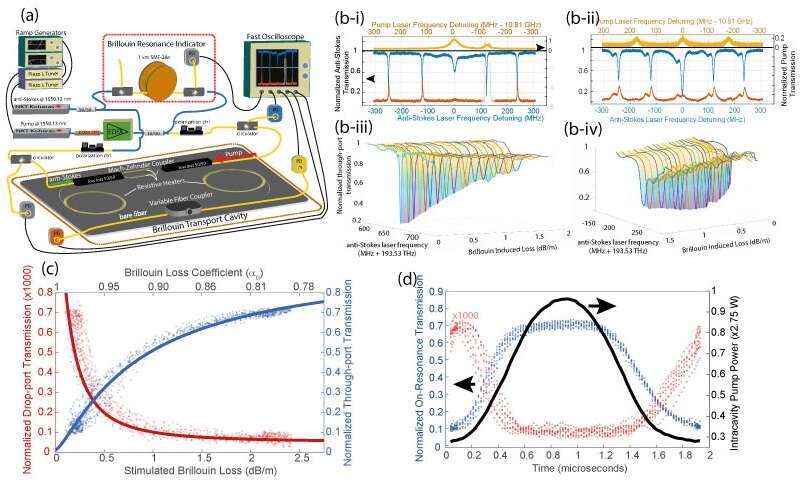
All-Optical Switching and Noise Assisted Transport via Brillouin Optical Zeno Effects in an Optical Fiber Cavity
2Now at: Laser Technology & Applications Group, MIT Lincoln Laboratory
3Now at: Department of Physics, Heriot-Watt University
4Now at: Enterprise Data Science Team, Royal Bank of Canada
5Now at: School of Physics and Astronomy, Shanghai Jiao Tong University
6Now at: Department of Physics of Complex Systems, Weizmann Institute of Science
7Now at: Department of Physics, University of Warwick
8Now at: Centre for Photonics & Photonic Materials, University of Bath
9Also at: Department of Physics, Imperial College, London
We exploit the Brillouin anti-Stokes absorption process inside an optical fibre cavity to demonstrate optical Zeno and anti-Zeno effects which enable all-optical switching and environmental noise assisted (quantum) coherent transport.
The optical Zeno (anti-Zeno) effects are processes by which strong absorption or frequent measurement in an optical cavity can inhibit (enhance) coupling into the cavity. These effects have been exploited in a variety of optical resonator platforms using nonlinear absorption processes such as two-photon absorption, different frequency generation and Raman scattering. Here we extend these concepts to Brillouin active optical resonators via the stimulated Brillouin anti-Stokes absorption process. In the anti-Zeno regime the cavity is initialized in the over-coupled state and tuned through critical-coupling and into under-coupling. This process is analogous to environmental noise assisted (quantum) coherent transport (ENAQCT) predicted to occur for exciton transport in photosynthetic pigment protein complexes. In the Zeno regime the cavity is initialized in critical-coupling and tuned strongly into under-coupling, enabling a high contrast all-optical routing function on the anti-Stokes signal with bandwidth limited by the cavity lifetime.
Figure 1(a) below summarizes the experiment. A fiber cavity is fabricated with an FSR (~120MHz) that is an integer fraction of the Brillouin phonon frequency (10.8 GHz) and with a Mach-Zehnder input coupler which provides differential coupling for Stokes and anti-Stokes frequencies. This suppresses oscillation of the Stokes field and provides a high-Q resonance for the anti-Stokes while allowing for tuning of the input coupling. Pump and anti-Stokes fields are derived from two DFB fiber lasers near 1550 nm and separated by the Brillouin phonon frequency. The pump is modulated and amplified. A small portion of pump and anti-Stokes are sent to a 1 Km length of SMF28e fiber which provides an error signal for laser frequency stabilization. The remaining power is sent into the Brillouin fiber cavity.
Figure 1(b) shows the cavity response at the (central) anti-Stokes resonance as a function of laser detuning (b-i,ii) and Brillouin loss(b-iii, iv). In (b-i,iii) the cavity is initially critically-coupled, as indicated by the deep on-resonance extinction of the adjacent resonances, and then tuned deep into the under-coupled regime resulting in strong decoupling of the resonance (increasing on-resonance transmission) with increasing pump power. The switching dynamics are shown in (c) as a function of Brillouin loss and (d) as a function of time. Blue (red) data and theory curves correspond to anti-Stokes at the through (drop)-port while yellow or black traces correspond to the pump signal. In (b-ii,iv) the cavity is initially over-coupled and is then tuned through critical-coupling wherein the coupling into the cavity is enhanced and then into under-coupling wherein the resonance decouples again. The enhanced coupling in the over-coupled regime corresponds to the ENA(Q)CT process.

Powered by Eventact EMS